Papers by Aleksandra Idczak
Studia Filmoznawcze, 2017
Stowarzyszenie Badaczy Popkultury i Edukacji Popkulturowej *Trickster*, Jul 11, 2018

The other horizon? Over Tadeusz Sobolewski's book "Kino swoimi słowami"... more The other horizon? Over Tadeusz Sobolewski's book "Kino swoimi słowami" The article is an attempt to look at the work of Tadeusz Sobolewski as a film critic in the context of his collected newspapers features in Kino swoimi słowami. Comparing earlier published texts (from the book "Za duży blask") with these from the new book, the author describes the change of perspective with which Sobolewski looks at a cinema in these two volumes. Showing style of Sobolewski's writtings, article identifies the differences beetwen the objectives of critical program (similar to hermeneutics) and the practical consequences, resulting from the selection of texts in the book. It also asks the question, what horizon opens up before cinema critics in connection with publishing Sobolewski's texts from Kino swoimi słowami in a strictly scientific series "Horyzonty kina" (The Horizons of Cinema).
JAMES BROUGHTON — PORTRAIT OF THE ARTIST FROM THE TIMES OF THE SEXUAL REVOLUTION The article is a... more JAMES BROUGHTON — PORTRAIT OF THE ARTIST FROM THE TIMES OF THE SEXUAL REVOLUTION The article is an attempt to introduce to Polish audience the artistic works and the person of James Broughton, one of the most important representatives of the American avant-garde. Outlining his profile, Idczak tries to show it as widely as possible against a broader background of the period, referring to debates about artistic strategies and poetic cinema fought by other avant-garde authors (for example Maya Deren). The main aim is to show Broughton mostly as an artist, not as a social activist. In his work the poetic and cinematic aspirations were intertwined and mutually conditioned. The article focuses on the themes found in the entire Broughton’s oeuvre: the body, eroticism, ecstasy, motion (as the most important notion of being), love, and finally — joy, as a form of artistic message and myth.

The aim of the paper is to describe the representations of masculinity in the works of James Brou... more The aim of the paper is to describe the representations of masculinity in the works of James Broughton, an American avant-garde filmmaker and a poet, conected to the San Francisco Renaissance group. He has also played an active role in a gay movement since the '50s and became one of its icons. While analyzing Broughton's movies the paper refers to Laura Mulvey's concept of breaking the visual pleasure. The main goal of the paper is to trace changes occurring in the creation of a hero and narrator's view in relation to their hetero- or non-heteronormativity. The author concentrates on the selected films from different periods of Broughton's career, e.g.: The Adventures of Jimmy, The Bed, The Golden Positions, Song of the Godbody, Hermes Bird, Devotions. The paper argues that in Broughton's work a viewer can find a shift from the creation of a male body as a constructed object of desire, through an attempt to deal with the theme of androgyny, to the affirmation of a non-canonical male body, which becomes the basis of the gay community.
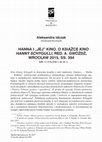
Studia Filmoznawcze
HANNA AND “HER” CINEMA. ON THE BOOK KINO HANNY SCHYGULLI, ED. A. GWÓŹDŹ, WROCŁAW 2015, 394 PP.The... more HANNA AND “HER” CINEMA. ON THE BOOK KINO HANNY SCHYGULLI, ED. A. GWÓŹDŹ, WROCŁAW 2015, 394 PP.The paper is a review of Kino Hanny Schygulli a volume published in the series “Niemcy — Media — Kultura” “Germany — Media — Culture”, edited by Andrzej Gwóźdź. Contributors of the publication represent various disciplines and present their own unique view. As a consequence, the main aim of the volume — which is to show a phenomenon of Schygulla’s art of acting in the broadest perspective — is fulfilled. The actress is presented as a creative entity, an exceptional co-author of films in which she performed. The author of the review claims that although the contributors analyze an interesting and still undescribed issue, the book does not meet the reader’s expectations, provoked by the editor’s initial assumptions expressed in the preface. The biggest deficiency of the volume seems to be the lack of solid theoretical background in describing the connection between the author and the actor de...
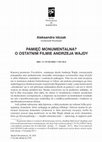
Studia Filmoznawcze
THE MONUMENTAL MEMORY? ON THE FINAL FILM OF ANDRZEJ WAJDA The paper attempts to study the Afterim... more THE MONUMENTAL MEMORY? ON THE FINAL FILM OF ANDRZEJ WAJDA The paper attempts to study the Afterimages, the last Andrzej Wajda’s film, in the light of its critical reception in Poland. The author investigates what place in collective memory of Polish viewers oc-cupies both the director and the protagonist — Władysław Strzemiński. The author argues that the exceptional circumstances, like jubilee celebrations and director’s funeral — turned critical attention away from the film itself to the entire director’s oeuvre. Afterimages, interpreted with the category of “monumental memory”, allows the author of the presented paper to show the place of Wajda’s work in Polish contemporary film culture. The author argues that this peculiar position is determined by a combination of social expectations and imaginations, and historical conditions, but above all by the way of perceiving the role of art in a changing society. In this context the question about problematic memory of the avant-garde s...
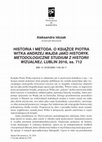
Studia Filmoznawcze
HISTORY AND METHOD. ON PIOTR WITEK’S BOOK ANDRZEJ WAJDA AS A HISTORIAN. METHODOLOGICAL STUDY OF V... more HISTORY AND METHOD. ON PIOTR WITEK’S BOOK ANDRZEJ WAJDA AS A HISTORIAN. METHODOLOGICAL STUDY OF VISUAL HISTORY, LUBLIN 2016, 712 PP.The review aims to shed light on the methodological concepts proposed in Piotr Witek’s book, and consider the possibility of applying them to the film studies. The reviewer highlights the book’s main concept, which is depicting Andrzej Wajda as a historian and treating his artistic works feature films, documentaries and TV Theatre as historical sources. This approach bases on visual history. In the paper the reviewer talks over the broadening of the frames of historiography done by Witek, and justifies this gesture as a well based on methodological roots of poststructuralism. Witek shows a broad interest in Wajda’s ways of understanding history, his philosophical assumptions, and the issue of artistics tools used in Wajda’s works about the past events. Apart from the reliable analysis of Wajda’s films, discussed book endeavor to build a conceptual platf...
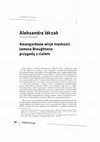
Panoptikum, 2015
The aim of the paper is to describe the representations of masculinity in the works of James Brou... more The aim of the paper is to describe the representations of masculinity in the works of James Broughton, an American avant-garde filmmaker and a poet, conected to the San Francisco Renaissance group. He has also played an active role in a gay movement since the '50s and became one of its icons. While analyzing Broughton's movies the paper refers to Laura Mulvey's concept of breaking the visual pleasure. The main goal of the paper is to trace changes occurring in the creation of a hero and narrator's view in relation to their hetero- or non-heteronormativity. The author concentrates on the selected films from different periods of Broughton's career, e.g.: The Adventures of Jimmy, The Bed, The Golden Positions, Song of the Godbody, Hermes Bird, Devotions. The paper argues that in Broughton's work a viewer can find a shift from the creation of a male body as a constructed object of desire, through an attempt to deal with the theme of androgyny, to the affirmation of a non-canonical male body, which becomes the basis of the gay community.
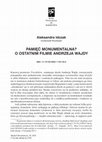
Studia Filmoznawcze, 2018
The Monumental Memory? On the Final Film of Andrzej Wajda
The paper attempts to study the "Afte... more The Monumental Memory? On the Final Film of Andrzej Wajda
The paper attempts to study the "Afterimages", the last Andrzej Wajda’s film, in the light of its critical reception in Poland. The author investigates what place in collective memory of polish viewers occupies both the director and the protagonist – Władysław Strzemiński. The author argues that the exceptional circumstances, like jubilee celebrations and director’s funeral - turned critical attention away from the film itself to the entire director’s oeuvre. "Afterimages", interpreted with the category of “monumental memory”, allows the author of the presented paper to show the place of Wajda's work in polish contemporary film culture. The author argues, that this peculiar position is determined by a combination of social expectations and imaginations, and historical conditions. But above all by the way of perceiving the role of art in a changing society. In this context the question about problematic memory of the avant-garde seems to be crucial.
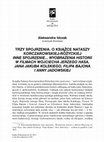
Studia Filmoznawcze, 2015
Review: THREE LOOKS. ON NATASZA KORCZAROWSKA-RÓŻYCKA’S BOOK INNE SPOJRZENIE... WYOBRAŻENIA HISTOR... more Review: THREE LOOKS. ON NATASZA KORCZAROWSKA-RÓŻYCKA’S BOOK INNE SPOJRZENIE... WYOBRAŻENIA HISTORII W FILMACH WOJCIECHA JERZEGO HASA, JANA JAKUBA KOLSKIEGO, FILIPA BAJONA I ANNY JADOWSKIEJ
The article is a review of Natasza Korczarowska-Różycka’s last book Inne spojrzenie... Wyobrażenia historii w fi lmach Wojciecha Jerzego Hasa, Jana Jakuba Kolskiego, Filipa Bajona i Anny Jadowskiej (Łódź 2013). According to the reviewer, the book is a bold attempt to combine film analysis with social issues. Korczarowska-Różycka proposed her own perspective of film reading on the intersection of close film analysis, sociological attitude and historical reflections about collective memory. She sees movie as a document of some socially established historical points of view or images, but also as a dynamic force, that is transforming and recreating these images. Her selection of directors and applied methodological basis allow her to avoid clichéd reflections on genre of historical cinema, but also lay her work open to the charge of certain arbitrariness. The author tries to not only present Korczarowska-Różycka’s book, but also bring out its theoretical background and place it in the broader context of memory studies.
JAMES BROUGHTON — PORTRAIT OF THE ARTIST FROM THE TIMES OF THE SEXUAL REVOLUTION
The article i... more JAMES BROUGHTON — PORTRAIT OF THE ARTIST FROM THE TIMES OF THE SEXUAL REVOLUTION
The article is an attempt to introduce to Polish audience the artistic works and the person of James Broughton, one of the most important representatives of the American avant-garde. Outlining his profile, Idczak tries to show it as widely as possible against a broader background of the period, referring to debates about artistic strategies and poetic cinema fought by other avant-garde authors (for example Maya Deren). The main aim is to show Broughton mostly as an artist, not as a social activist. In his work the poetic and cinematic aspirations were intertwined and mutually conditioned. The article focuses on the themes found in the entire Broughton’s oeuvre: the body, eroticism, ecstasy, motion (as the most important notion of being), love, and finally — joy, as a form of artistic message and myth.
Book Reviews by Aleksandra Idczak
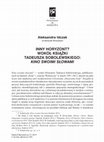
Studia Filmoznawcze, 2014
The other horizon? Over Tadeusz Sobolewski's book "Kino swoimi słowami"
The article is an attemp... more The other horizon? Over Tadeusz Sobolewski's book "Kino swoimi słowami"
The article is an attempt to look at the work of Tadeusz Sobolewski as a film critic in the context of his collected newspapers features in Kino swoimi słowami. Comparing earlier published texts (from the book "Za duży blask") with these from the new book, the author describes the change of perspective with which Sobolewski looks at a cinema in these two volumes. Showing style of Sobolewski's writtings, article identifies the differences beetwen the objectives of critical program (similar to hermeneutics) and the practical consequences, resulting from the selection of texts in the book. It also asks the question, what horizon opens up before cinema critics in connection with publishing Sobolewski's texts from Kino swoimi słowami in a strictly scientific series "Horyzonty kina" (The Horizons of Cinema).

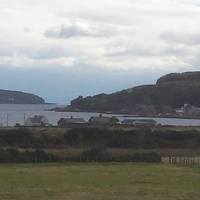






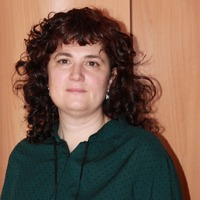


Uploads
Papers by Aleksandra Idczak
The paper attempts to study the "Afterimages", the last Andrzej Wajda’s film, in the light of its critical reception in Poland. The author investigates what place in collective memory of polish viewers occupies both the director and the protagonist – Władysław Strzemiński. The author argues that the exceptional circumstances, like jubilee celebrations and director’s funeral - turned critical attention away from the film itself to the entire director’s oeuvre. "Afterimages", interpreted with the category of “monumental memory”, allows the author of the presented paper to show the place of Wajda's work in polish contemporary film culture. The author argues, that this peculiar position is determined by a combination of social expectations and imaginations, and historical conditions. But above all by the way of perceiving the role of art in a changing society. In this context the question about problematic memory of the avant-garde seems to be crucial.
The article is a review of Natasza Korczarowska-Różycka’s last book Inne spojrzenie... Wyobrażenia historii w fi lmach Wojciecha Jerzego Hasa, Jana Jakuba Kolskiego, Filipa Bajona i Anny Jadowskiej (Łódź 2013). According to the reviewer, the book is a bold attempt to combine film analysis with social issues. Korczarowska-Różycka proposed her own perspective of film reading on the intersection of close film analysis, sociological attitude and historical reflections about collective memory. She sees movie as a document of some socially established historical points of view or images, but also as a dynamic force, that is transforming and recreating these images. Her selection of directors and applied methodological basis allow her to avoid clichéd reflections on genre of historical cinema, but also lay her work open to the charge of certain arbitrariness. The author tries to not only present Korczarowska-Różycka’s book, but also bring out its theoretical background and place it in the broader context of memory studies.
The article is an attempt to introduce to Polish audience the artistic works and the person of James Broughton, one of the most important representatives of the American avant-garde. Outlining his profile, Idczak tries to show it as widely as possible against a broader background of the period, referring to debates about artistic strategies and poetic cinema fought by other avant-garde authors (for example Maya Deren). The main aim is to show Broughton mostly as an artist, not as a social activist. In his work the poetic and cinematic aspirations were intertwined and mutually conditioned. The article focuses on the themes found in the entire Broughton’s oeuvre: the body, eroticism, ecstasy, motion (as the most important notion of being), love, and finally — joy, as a form of artistic message and myth.
Book Reviews by Aleksandra Idczak
The article is an attempt to look at the work of Tadeusz Sobolewski as a film critic in the context of his collected newspapers features in Kino swoimi słowami. Comparing earlier published texts (from the book "Za duży blask") with these from the new book, the author describes the change of perspective with which Sobolewski looks at a cinema in these two volumes. Showing style of Sobolewski's writtings, article identifies the differences beetwen the objectives of critical program (similar to hermeneutics) and the practical consequences, resulting from the selection of texts in the book. It also asks the question, what horizon opens up before cinema critics in connection with publishing Sobolewski's texts from Kino swoimi słowami in a strictly scientific series "Horyzonty kina" (The Horizons of Cinema).
The paper attempts to study the "Afterimages", the last Andrzej Wajda’s film, in the light of its critical reception in Poland. The author investigates what place in collective memory of polish viewers occupies both the director and the protagonist – Władysław Strzemiński. The author argues that the exceptional circumstances, like jubilee celebrations and director’s funeral - turned critical attention away from the film itself to the entire director’s oeuvre. "Afterimages", interpreted with the category of “monumental memory”, allows the author of the presented paper to show the place of Wajda's work in polish contemporary film culture. The author argues, that this peculiar position is determined by a combination of social expectations and imaginations, and historical conditions. But above all by the way of perceiving the role of art in a changing society. In this context the question about problematic memory of the avant-garde seems to be crucial.
The article is a review of Natasza Korczarowska-Różycka’s last book Inne spojrzenie... Wyobrażenia historii w fi lmach Wojciecha Jerzego Hasa, Jana Jakuba Kolskiego, Filipa Bajona i Anny Jadowskiej (Łódź 2013). According to the reviewer, the book is a bold attempt to combine film analysis with social issues. Korczarowska-Różycka proposed her own perspective of film reading on the intersection of close film analysis, sociological attitude and historical reflections about collective memory. She sees movie as a document of some socially established historical points of view or images, but also as a dynamic force, that is transforming and recreating these images. Her selection of directors and applied methodological basis allow her to avoid clichéd reflections on genre of historical cinema, but also lay her work open to the charge of certain arbitrariness. The author tries to not only present Korczarowska-Różycka’s book, but also bring out its theoretical background and place it in the broader context of memory studies.
The article is an attempt to introduce to Polish audience the artistic works and the person of James Broughton, one of the most important representatives of the American avant-garde. Outlining his profile, Idczak tries to show it as widely as possible against a broader background of the period, referring to debates about artistic strategies and poetic cinema fought by other avant-garde authors (for example Maya Deren). The main aim is to show Broughton mostly as an artist, not as a social activist. In his work the poetic and cinematic aspirations were intertwined and mutually conditioned. The article focuses on the themes found in the entire Broughton’s oeuvre: the body, eroticism, ecstasy, motion (as the most important notion of being), love, and finally — joy, as a form of artistic message and myth.
The article is an attempt to look at the work of Tadeusz Sobolewski as a film critic in the context of his collected newspapers features in Kino swoimi słowami. Comparing earlier published texts (from the book "Za duży blask") with these from the new book, the author describes the change of perspective with which Sobolewski looks at a cinema in these two volumes. Showing style of Sobolewski's writtings, article identifies the differences beetwen the objectives of critical program (similar to hermeneutics) and the practical consequences, resulting from the selection of texts in the book. It also asks the question, what horizon opens up before cinema critics in connection with publishing Sobolewski's texts from Kino swoimi słowami in a strictly scientific series "Horyzonty kina" (The Horizons of Cinema).